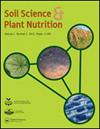Effects of drought stress on the oxidation of the reaction center chlorophyll of photosystem I and grain yield in paddy-field grown rice plants
IF 1.8
4区 农林科学
Q3 ENVIRONMENTAL SCIENCES
引用次数: 0
Abstract
ABSTRACT Drought is a serious abiotic stress that leads to decreased yield. In pot experiments, the reaction center chlorophyll of photosystem I (PSI) (P700) has been reported to be oxidized in response to drought stress. In the present study, we examined whether drought stress that decreases grain yield was detected by P700 oxidation in paddy-field-grown rice (Oryza sativa L.) plants. The P700 reduction and SPAD values were also evaluated. Drought stress was imposed by the prolonged mid-season drainage in 2019 and 2020. P700 oxidation was measured at saturated CO2 levels before heading. P700 oxidation was not stimulated in the 2019-drought plots. In contrast, P700 oxidation was stimulated in the 2020-drought plot. However, this phenomenon in 2020 was primarily accounted for by decreases in total leaf-N levels, as previously observed in the rice plants grown under low N availability. Rough rice yields and ratios of filled spikelets tended to decrease in the drought plots. Therefore, drought stress responsible for a decrease in grain yields could not be directly detected by P700 oxidation in paddy-field-grown rice plants, whereas the P700 oxidation responded to changes in total leaf-N levels due to the drought stress treatment. The same conclusion was drawn for the P700 reduction and SPAD value.干旱胁迫对水稻田水稻光系统I反应中心叶绿素氧化及产量的影响
干旱是导致作物减产的严重非生物胁迫。在盆栽试验中,有报道称光合系统I (PSI)反应中心叶绿素(P700)在干旱胁迫下被氧化。在本研究中,我们研究了水稻(Oryza sativa L.)植株是否通过P700氧化来检测干旱胁迫降低籽粒产量。还评估了P700复位和SPAD值。2019年和2020年季中排水时间延长造成了干旱压力。抽头前在饱和CO2水平下测量P700氧化。在2019年干旱样地,P700氧化未受到刺激。相比之下,P700氧化在2020-干旱样地受到刺激。然而,2020年的这一现象主要是由于叶片总氮水平的下降,正如之前在低氮有效性条件下种植的水稻中观察到的那样。旱地糙米产量和灌浆小穗比呈下降趋势。因此,干旱胁迫对水稻产量的影响不能通过P700氧化直接检测到,而P700氧化响应的是干旱胁迫处理导致的叶片总氮水平的变化。P700降低和SPAD值也得出了相同的结论。
本文章由计算机程序翻译,如有差异,请以英文原文为准。
求助全文
约1分钟内获得全文
求助全文
来源期刊

Soil Science and Plant Nutrition
农林科学-农艺学
CiteScore
4.80
自引率
15.00%
发文量
56
审稿时长
18-36 weeks
期刊介绍:
Soil Science and Plant Nutrition is the official English journal of the Japanese Society of Soil Science and Plant Nutrition (JSSSPN), and publishes original research and reviews in soil physics, chemistry and mineralogy; soil biology; plant nutrition; soil genesis, classification and survey; soil fertility; fertilizers and soil amendments; environment; socio cultural soil science. The Journal publishes full length papers, short papers, and reviews.
 求助内容:
求助内容: 应助结果提醒方式:
应助结果提醒方式:


